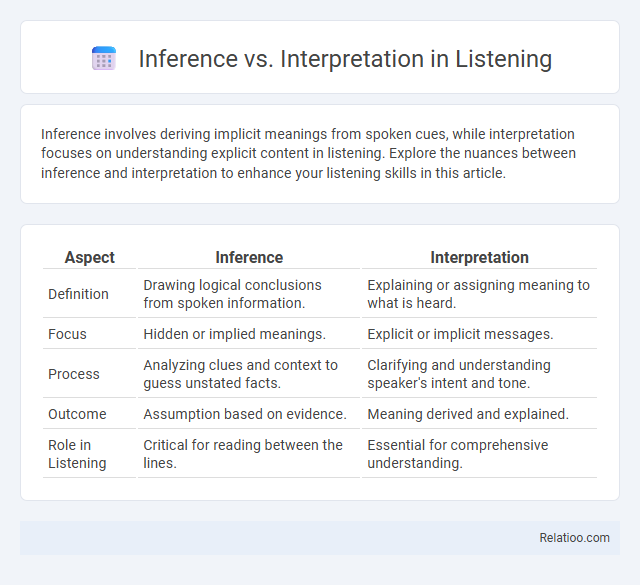Inference involves deriving implicit meanings from spoken cues, while interpretation focuses on understanding explicit content in listening. Explore the nuances between inference and interpretation to enhance your listening skills in this article.
Table of Comparison
| Aspect | Inference | Interpretation |
|---|---|---|
| Definition | Drawing logical conclusions from spoken information. | Explaining or assigning meaning to what is heard. |
| Focus | Hidden or implied meanings. | Explicit or implicit messages. |
| Process | Analyzing clues and context to guess unstated facts. | Clarifying and understanding speaker's intent and tone. |
| Outcome | Assumption based on evidence. | Meaning derived and explained. |
| Role in Listening | Critical for reading between the lines. | Essential for comprehensive understanding. |
Understanding Inference in Listening
Understanding inference in listening involves the ability to draw conclusions beyond the explicit content of spoken language by analyzing tone, context, and non-verbal cues. This cognitive process allows listeners to grasp implied meanings, intentions, and emotions that are not directly stated, enhancing overall comprehension. Effective inference in listening is critical for interpreting subtle messages and filling gaps in communication, leading to a deeper understanding of the speaker's intent.
Defining Interpretation in the Listening Process
Interpretation in the listening process involves assigning meaning to the sounds and words heard, transforming auditory input into coherent ideas. Unlike inference, which draws conclusions based on implicit information, interpretation is the active decoding and understanding of explicit messages conveyed by the speaker. Effective interpretation relies on contextual knowledge and language proficiency to accurately grasp the intended message during listening.
Key Differences Between Inference and Interpretation
Inference involves drawing logical conclusions based on evidence and reasoning during listening, whereas interpretation emphasizes understanding and explaining the meaning or significance of the information heard. Inference relies heavily on context clues and prior knowledge to fill in gaps, while interpretation requires analyzing tone, intent, and underlying messages. The key difference is that inference is about deriving unstated information, while interpretation is about assigning meaning to the communicated content.
The Role of Context in Making Inferences
Understanding the role of context is crucial in making accurate inferences during listening, as it provides the background and situational clues needed to decode implied meanings beyond the spoken words. Inference involves actively using contextual information to fill gaps and grasp the speaker's intended message, while interpretation focuses more on explicating the explicit content without extensive reliance on external context. Your ability to leverage context enhances comprehension by bridging implicit cues and fostering a deeper understanding of the communication.
Interpretation: Decoding Speaker’s Intentions
Interpretation in listening involves decoding the speaker's intentions by analyzing tone, context, and non-verbal cues to grasp underlying meanings beyond the literal words. Your ability to accurately interpret enhances comprehension and fosters effective communication by recognizing emotions, sarcasm, or implied messages. Mastering interpretation sharpens listening skills, allowing you to respond appropriately to the speaker's true purpose.
Cognitive Skills Involved in Inference and Interpretation
Inference in listening involves the cognitive skill of drawing conclusions based on implicit information, requiring the integration of contextual clues with prior knowledge. Interpretation demands higher-level cognitive processing, including understanding speaker intent, tone, and nuances to derive meaning beyond the literal content. Both skills engage working memory, attention, and critical thinking, but interpretation often requires more advanced metacognitive awareness to accurately decode underlying messages.
Common Barriers to Effective Inference and Interpretation
Common barriers to effective inference and interpretation during listening include background noise, cognitive overload, and personal biases that distort the message's meaning. Your ability to accurately infer and interpret depends on active listening, contextual understanding, and critical thinking to overcome these obstacles. Misinterpreting tone, ambiguous language, and preconceived notions further complicate the process of drawing accurate conclusions from spoken information.
Importance of Accurate Inference and Interpretation in Communication
Accurate inference and interpretation are crucial in effective communication, as they ensure the listener correctly understands the speaker's intended meaning beyond the literal words. Misinterpreting or making faulty inferences can lead to misunderstandings, conflicts, and misinformation. Developing strong skills in both inference and interpretation enhances meaningful interaction and successful information exchange.
Practical Strategies for Improving Listening Skills
Effective listening requires distinguishing inference from interpretation to improve comprehension and response accuracy. Inference involves drawing logical conclusions from explicit information during listening, while interpretation focuses on understanding the speaker's intent and emotional context. Practical strategies include active note-taking to capture key details for inference and reflective questioning to clarify meaning, enhancing overall listening proficiency.
Inference vs Interpretation: Real-World Listening Examples
Inference involves drawing conclusions from implied information during listening, such as detecting sarcasm or underlying emotions in a speaker's tone. Interpretation requires understanding and explaining the explicit content and context, like summarizing a lecture or clarifying instructions. Real-world listening examples include inferring a coworker's frustration despite polite words and interpreting customer feedback to improve service strategies.

Infographic: Inference vs Interpretation in Listening
 relatioo.com
relatioo.com